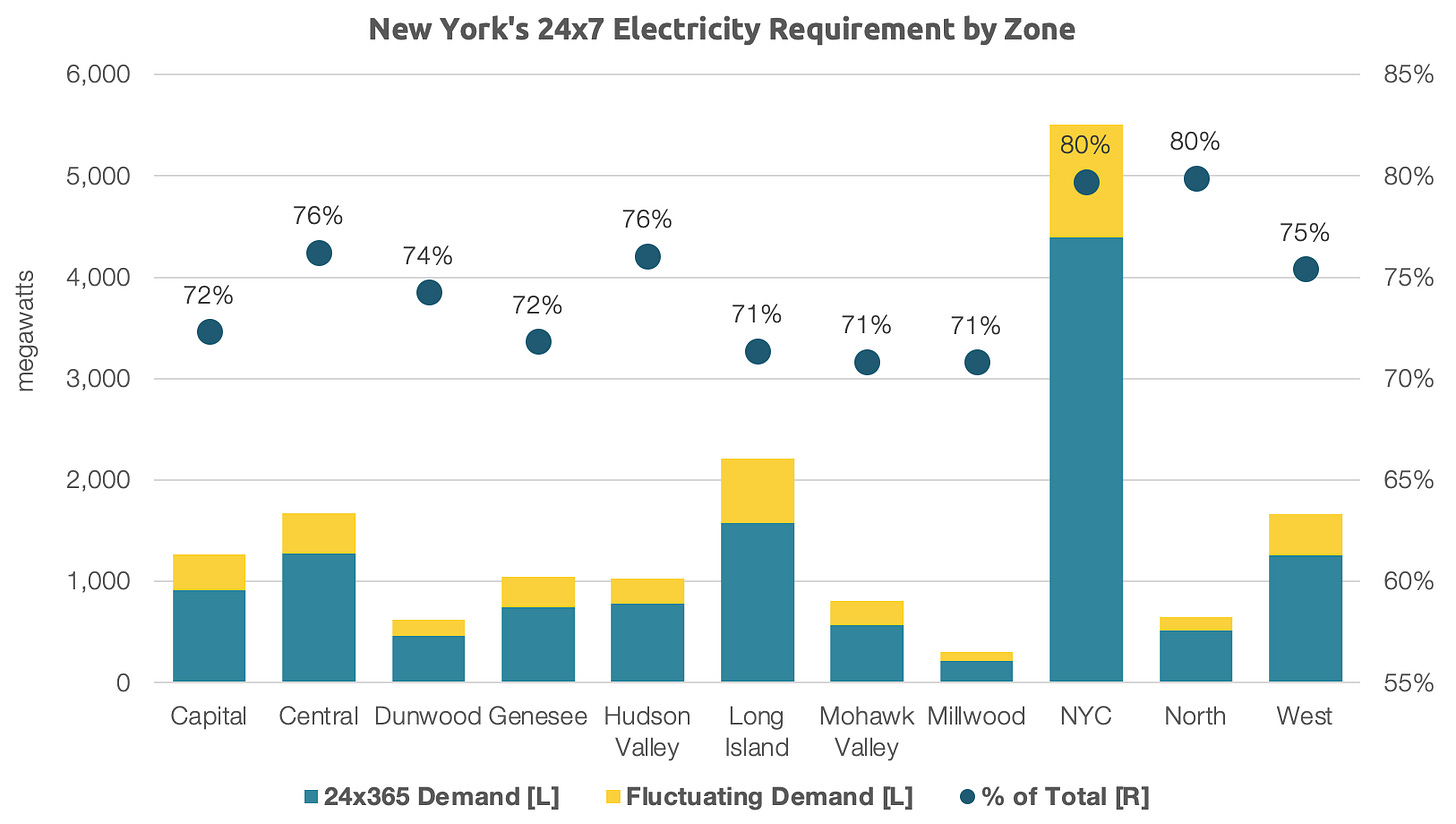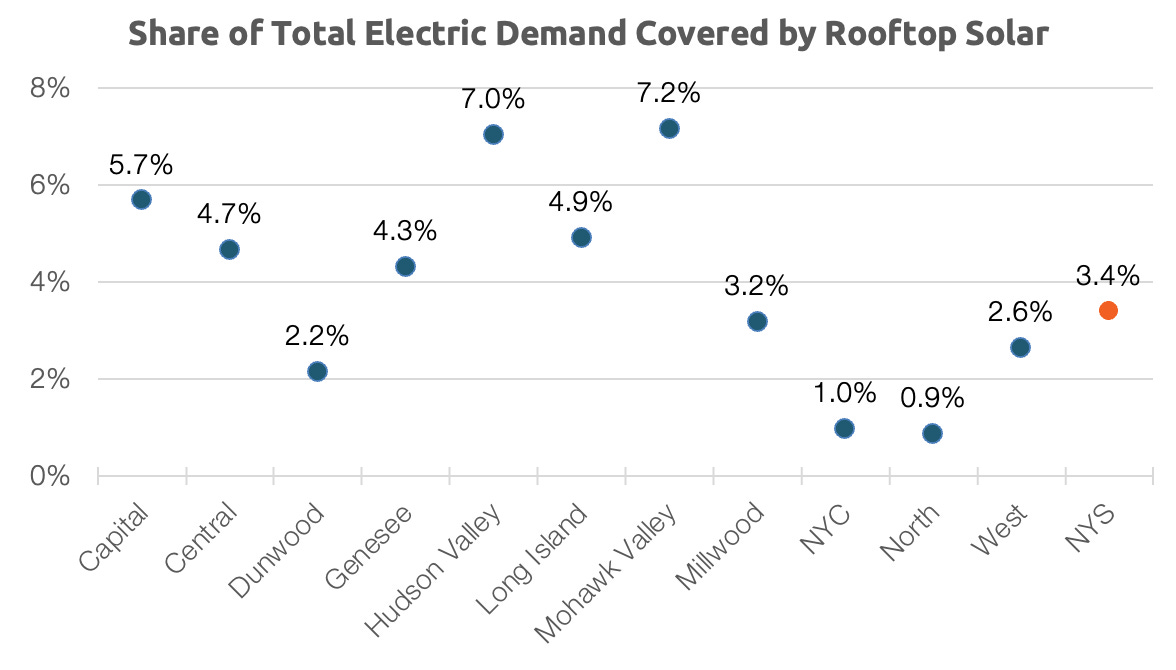As New York State Energy Planning Board charts our energy future to implement the Climate Leadership and Community Protection Act (CLCPA), it is essential that we consider daily/hourly/seasonal demand profiles for each consuming region. Such sober analysis would help identify what combination of generation technologies can reliably serve the electricity loads and avoid blackouts… all while being cost effective and environmentally sustainable.
Demand
The below chart illustrates the daily grid electric load for New York State. There is an orange dot for each day corresponding to the average load in megawatts (MWs).
In 2023, daily average load fluctuated between 13,227 MW and 24,619 MW. The red line corresponds to load on maximum day (September 6th), 24,619 MW. The teal line corresponds to load on minimum day (April 9th), 13,227 MW. Furthermore, on September 6th, the intra-day peak reached 30,638 MW. The grid must be robust enough to cater to this peak demand, and by an ample margin.
However, let’s focus on minimum daily load. The rectangle underneath the teal line represents New York’s grid electricity needs that is constant over 365 days of the year. Since the 2023 total demand was 16,785 MW, 79% of New York’s electricity consumption is constant — also known as “baseload demand.”
The below chart graphs minimum daily load (in gigawatt-hours, GWh) against total demand over the 7 years 2017-2023. The light teal box shows the range of baseload demand over the period. Over 3/4 of New York’s grid electric consumption is constant.
Baseload demand is above 70% for all New York Control Area (NYCA) zones managed by the grid operator, New York Independent System Operator (NYISO).
NYCA zones are illustrated in the below map.
On Demand Electricity
Electric supply has to exactly match demand at all times under all conditions in order to prevent blackouts. Aidan Morrison, now the Director of Energy Research at Australia’s Centre for Independent Studies, uses the below analogy to illuminate two delivery models: “irrigation” and “scuba.” Plants need a sufficient quantum of water over a growing season. A week without rain is fine as long as the shortfall is made up later through a system of irrigation. He contrasts this with how animals need oxygen: we need exactly the right amount at all times. This requires a scuba-style delivery system.
Human civilization’s energy needs are more akin to how mammals breathe, rather than how plants absorb water. This makes sense when we think about the intensive care units, elevators, and factories. Thus, energy delivery has be via a scuba-type system.
Supply
The below chart is of daily generation by technology type. The chart makes evident how steady generation from nuclear and hydro supply part of the baseload demand. Intermittent renewable generation from wind and solar is backed up by fast-ramping fossil combustion to ensure grid reliability.
Nuclear plants choose to refuel during demand “shoulder season” during the spring or the fall.
The below chart is the average hourly demand for three months (August, December, and April), along with the impact of rooftop solar. The lighter lines show total electricity demand including rooftop solar generation, while the darler lines show grid load, net of rooftop solar. For example, we can see that the August lines (with and without rooftop solar) are much farther apart than the December lines. Rooftop solar helps to shave peak demand during summer months. However, its contribution is minimal during the shorter days of winter.
As New York embarks on benefitial electrification of transportation (via electric vehicles) and space heating (via heat pumps), electricity demand during winter is expected to increase. This switch is slated to make New York’s electricity system a “winter peaking” one. This exacerbates the disparity between solar generation and electricity demand.
Rooftop solar covers 3.4% of New York State electricity needs. While solar irradiation is highest downstate, so is population density, thereby limiting its potential contribution to overall demand.
Future
New York needs to systematically evaluate generation sources and how they contribute to a functioning energy system that balances the competing priorities of affordability, reliability, and sustainability. New York’s Draft Blueprint for Consideration of Advanced Nuclear Technologies is a welcome contribution to this understanding.
[S]tudies identify a critical need in the path to a zero emissions grid in New York: controllable clean electricity technologies that can reliably meet the demand for power throughout the year, even when onshore and offshore wind and solar energy are less available.
Advanced nuclear technologies could offer attractive possibilities for New York, with its scalability, economic development, low land use, and potential applications of process heat. It may represent an opportunity for additional grid capacity to support an electrifying economy, that can complement New York’s buildout of renewables.
The U.S. Department of Energy identified the human and environmental attributes of various generation technologies in Pathways to Commercial Liftoff: Advanced Nuclear, as seen in the table below.
New York should consider how energy technologies impact communities, economic development, and the environment and develop effective, efficient, and equitable solutions rather than pursue a “maximize renewables” and “fill the gaps” strategy.
References
Miltechntac (2022). CSIRO's 'sunk cost' integration of renewables in GenCost
New York Independent System Operator (NYISO) - Open Access Same-Time Information System (OASIS)
Seneviratne (2022). Electric Evolution: New York's Electricity System, Prices, and Climate Plans. Harvard Center for Geographic Analysis StoryMaps
U.S. Department of Energy (2023). Pathways to Commercial Liftoff: Advanced Nuclear












Isuru, you raise excellent points regarding the necessity of "always-on" electricity. As an example, a refrigerator needs access to always on power. Ditto for factories, hospitals, and military bases. Here in California, our lives depend on pumping and treating water in our parched state. Another grid need is for sufficient synchronous grid inertia (SGI,) For an introduction, see https://greennuke.substack.com/p/why-is-grid-inertia-important
Well done Isuru